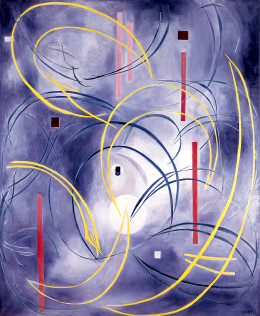Hilla Rebay and Solomon R. Guggenheim
dal 12/5/2006 al 9/8/2006
Segnalato da
12/5/2006
Hilla Rebay and Solomon R. Guggenheim
Deutsche Guggenheim, Berlin
The exhibition comprises Rebay’s representational and non-objective works on paper, including watercolors, drawings, and collages; non-objective paintings; and the formal portrait of Solomon R. Guggenheim (1861-1949) that first brought the artist and the patron together.

Art of Tomorrow
Art of Tomorrow: Hilla Rebay and Solomon R. Guggenheim, the first exhibition dedicated to the entire career of Hilla Rebay, opens at the Deutsche Guggenheim, Berlin, on May 13, 2006, through August 10, 2006. Organized by the Solomon R. Guggenheim Foundation in collaboration with the Museum Villa Stuck, Munich, and the Schlossmuseum Murnau, the exhibition explores the full range of Hilla Rebay’s creative production. The presentation of this exhibition in Berlin, New York and Murnau has been sponsored by Deutsche Bank. Special thanks to The Hilla Rebay Foundation for its assistance in the realization of this exhibition.
The German-born artist Hilla Rebay (1890-1967) was one of the founders of the Solomon R. Guggenheim Museum—originally named the Museum of Non-Objective Painting— in 1939, as well as its first curator and director.
The exhibition comprises Rebay’s representational and non-objective works on paper, including watercolors, drawings, and collages; non-objective paintings; and the formal portrait of Solomon R. Guggenheim (1861-1949) that first brought the artist and the patron together. Also included are several key works by her colleagues and friends such as Jean Arp, Rudolf Bauer, Vasily Kandinsky, Hans Richter, and Kurt Schwitters, as well as works by fellow artists Paul Klee, Fernand Le'ger, La'szlo' Moholy-Nagy, Otto Nebel, Ben Nicholson, Friedrich Vordemberge-Gildewart, Georges Valmier, and Maria Helena Vieira da Silva. Such works were acquired by Rebay and Guggenheim between 1929 and 1939 and shown in the first landmark exhibition of the Museum of Non-Objective Painting in New York in 1939.
A versatile and prolific artist who studied in Munich, Berlin, and Paris, Hilla Rebay embraced the idea of “non-objective" art as both an aesthetic style and a manifestation of spirituality. She began to exhibit at the age of 22 and participated in the artistic avant-garde, including the Dada movement in Zurich and Herwarth Walden’s innovative and influential gallery Der Sturm in Berlin, where she was drawn to the work of modernist artists, including Arp, Bauer, Kandinsky, Klee, Richter, and Schwitters. In Berlin, Rebay discovered new artistic forms and created particularly expressive non-objective paintings, watercolors, and collages.
When Rebay moved to America in 1927, she was commissioned by Solomon R. Guggenheim to paint his portrait and began her mission to encourage him to collect non-objective painting, which she considered to be the highest form of art. Rebay introduced the American “Copper King" to Kandinsky. With her encouragement, he purchased more than 150 of the artist’s works as well as paintings by other twentieth-century abstract and non-objective artists, including Bauer, Le'ger, and Moholy-Nagy, among others. In 1937, the Solomon R. Guggenheim Foundation was established, and Rebay and Guggenheim envisioned the construction of a museum to house his magnificent collection of modern art. In 1939, Guggenheim rented a building on East Fifty Fourth Street in New York, which Rebay transformed into a temporary exhibition space, called the Museum of Non-Objective Painting; in 1947 it would move to a townhouse at 1071 Fifth Avenue.
An independent woman of impressive energy, Rebay organized exhibitions at the museum and a series of traveling exhibitions devoted to the collection. She advised Guggenheim until his death in 1949 on the purchase of works for his ever-growing collection. In 1943, Rebay contacted architect Frank Lloyd Wright to design the museum of her dreams, “a temple to non-objectivity," which would finally open in 1959. By that time, Wright and Guggenheim had already passed away and Rebay had retired from the museum.
The extraordinary collaboration between Hilla Rebay and Solomon R. Guggenheim resulted in one of the world’s finest collections of early twentieth-century modernism. This accomplishment was expressed in particular through Art of Tomorrow, the opening exhibition at the Museum of Non-Objective Painting, which introduced key works from Guggenheim’s collection to a New York audience in 1939. The present exhibition - with its first venues in New York , Munich and Murnau -, curated by Karole Vail , Guggenheim Museum new york; Jo-Anne Birnie Dankzer, Museum Villa Stuck Munich and Brigitte Salmen, Schlossmuseum Murnau showcases important works by the artists that Guggenheim collected under Rebay’s guidance and who are documented in the Art of Tomorrow catalogue published for the opening of the museum, thus attesting to the prescience of the museum’s founders and the historical importance of the collection today.
The exhibition is accompanied by a fully illustrated catalogue in color and with essays by the curators; noted scholars Vivian E. Barnett and Robert Rosenblum; and Hilla Rebay’s nephew Roland von Rebay, an architect who apprenticed under Frank Lloyd Wright and can be purchased at the price of 28.50 Euros.
The show is accompanied by numerous special events such as lectures, films, music and a children’s program. Free guided tours are offered daily at 6 p.m. The supporting program is rounded off by the well-known Lunch Lectures, Wednesdays at 1 p.m., and the Keynote Tours, Sundays at 11:30 a.m. Please check the enclosed material for more detailed information.
Opening: 13 May 2006
Deutsche Guggenheim
Unter den Linden 13/15 - Berlin
Hours: daily 11 a.m. to 8 p.m. thursdays to 10 p.m.



